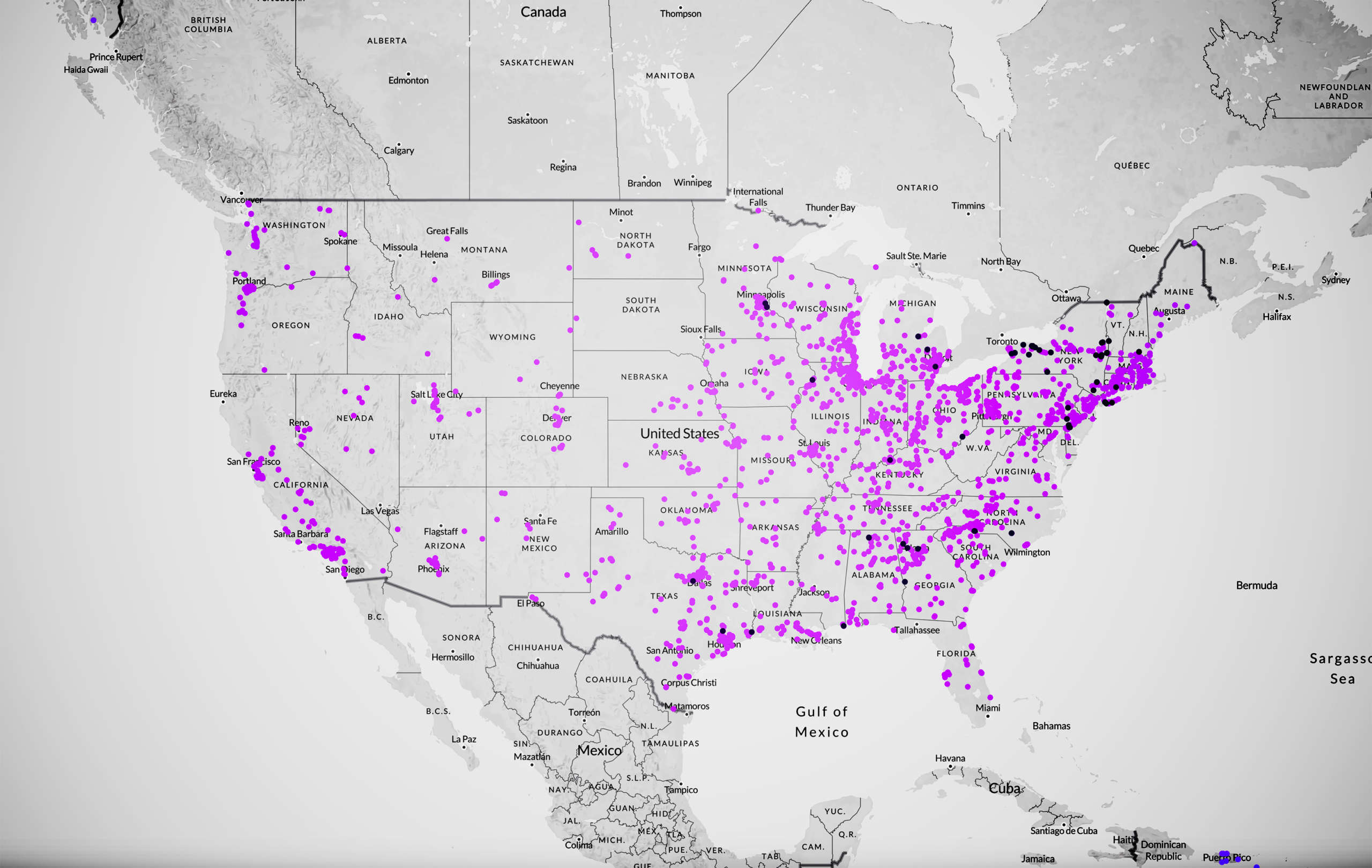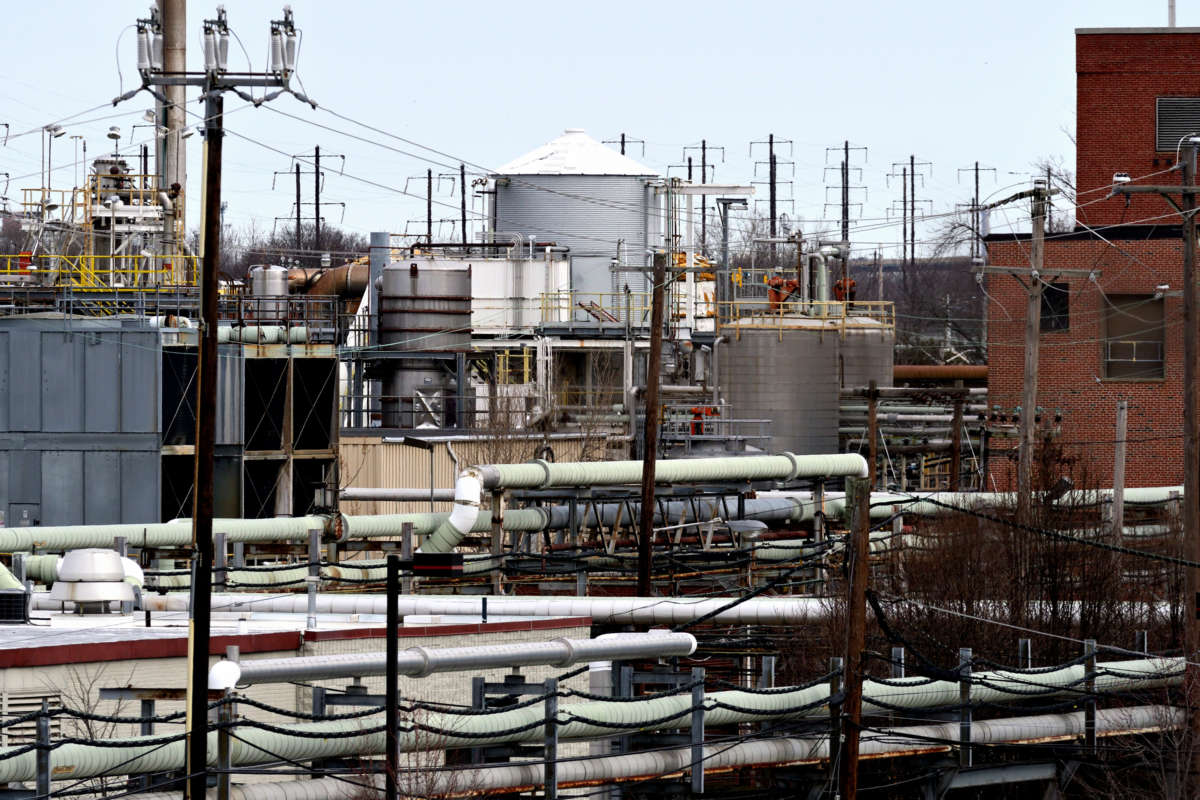Rep. Chris Pappas has a pollution double whammy in his New Hampshire congressional district. A plastics manufacturer contaminated public water wells with per- and polyfluoroalkyl substances, or PFAS, in the town of Merrimack. Residents of the town learned in 2016 that they had been drinking water laced with tasteless, odorless toxic chemicals for two decades. In another part of the district, firefighting foam used at an Air Force installation contaminated the surrounding environment with PFAS.
New Hampshire regulators are currently investigating more than two dozen PFAS contamination sites across the state, and Pappas is not alone in Congress. PFAS are a broad group of chemicals that have been used for decades in a variety of consumer products and manufacturing processes for their nonstick, stain-repellent and waterproofing properties. These chemicals break down incredibly slowly in the environment, and researchers suspect that small amounts are detectable in every major source of drinking water in the United States.
Now, as the nation reels from a fresh public health crisis caused by the novel coronavirus, new research suggests that more than 2,500 industrial facilities located in virtually every congressional district could be discharging PFAS into the air and water in the absence of federal regulations. While the Trump administration has released a PFAS “action plan,” the White House pushed back against legislation passed by House Democrats that would require the Environmental Protection Agency (EPA) to draw up tough PFAS regulations and force polluters to assist in cleanup efforts.
“It’s amazing to me that there is no regulation of PFAS under the Clean Water Act right now in a way that can protect our communities from the really toxic impacts that PFAS poses to individuals’ health and well-being,” Pappas told reporters during a Zoom conference on Thursday.
The two most notorious PFAS chemicals, PFOS and PFOA, were originally used in Dupont’s Teflon and 3M’s Scotchgard and are linked to health problems such as weakened childhood immunity, cancer, and kidney and thyroid disease. PFOS and PFOA have been phased out of use — although both persist in the environment. Independent research suggests that dozens of other PFAS chemicals developed to replace PFOS and PFOA may also have harmful impacts on the body, but with hundreds of PFAS on the market, it’s difficult for researchers to keep up.

Pappas’s district is home to two primary examples of the major sources of PFAS pollution nationwide: an industrial manufacturing plant and an Air Force installation where firefighting foam laced with PFAS was in use for years. Nationally, there are 2,500 industrial manufacturing and chemical facilities that could be releasing PFAS into the air and water, according to a new dataset and map released by the Environmental Working Group (EWG) on Thursday. The group previously identified and mapped 678 military sites nationwide where PFAS is known or suspected to have been discharged into the environment.
Lawmakers Say Trump’s EPA Is Dragging Its Feet
Various PFAS chemicals are used by a variety of industries for manufacturing and to coat their products. Plastics manufacturers, carpetmakers, commercial printers and many others use PFAS chemicals, according to Scott Faber, EWG’s vice president of government affairs. Other major sources of pollution include 28 industrial chemical facilities nationwide that report manufacturing or using large amounts of PFAS.
One of the most notorious polluters is the Chemours chemical plant in North Carolina, which is currently under state orders to clean up PFAS pollution that contaminated groundwater and the Cape Fear River. Dupont and 3M, two former manufacturers of PFOS and PFOA that helped invent the PFAS class of chemicals, concealed evidence that the chemicals were hazardous from the public for decades.
Faber said researchers dug through EPA data sets and other public records to identify and map out potential PFAS polluters based on what types of products they use or produce, but he cautioned that each facility is only suspected of discharging PFAS pollution. Thanks to weak federal regulation, there is currently no way to confirm whether each facility is discharging PFAS, and how much. While some facilities are already confirmed sources of drinking water contamination, tap water near others has yet to be tested.
“Unfortunately, even though the EPA has known for decades that PFAS is toxic and building up in our blood, EPA has so far failed to add PFAS to what’s known as the Toxic Release Inventory,” Faber said, referring to the EPA’s system for tracking toxic industrial release.
Lawmakers only recently added 172 PFAS to the list of toxic chemicals that chemical plants and industrial manufactures are required to report to the EPA after discharging them into the environment, and Faber said that data on that pollution will not be available until next year. Every year, industrial facilities report discharging millions of pounds of toxic chemicals to the EPA, but environmentalists and lawmakers say President Trump’s EPA has dragged its feet in responding to PFAS.
Rep. Harley Rouda is a Democrat whose district includes parts of Orange County, California, where a local utility has invested $1 million in equipment to test for PFOS and PFOA in drinking water. Rouda said the COVID-19 outbreak is not hampering this effort because the water utilities are considered “essential,” but he does not expect any help from the Trump administration, which has taken a “systematic approach” to unraveling the EPA’s obligations to protect the environment under federal law.
Indeed, the Trump administration has relaxed federal environmental enforcement at the EPA in response to the COVID-19 crisis, allowing the fossil fuel industry to spew more pollution into the air without facing fines. Rouda pointed to California’s popular auto emissions standards, which the administration forced the state to roll back after a long legal battle.
“I have no doubt that, if they have the opportunity to do it on the PFAS front, they will do it there as well,” Rouda told reporters on Thursday. “And I think that’s part of the reason you haven’t seen the EPA honor what they said about coming out quickly with standards specifically on PFAS discharges and a greater regulatory framework to make sure we save American lives, when you get right down to it.”
Currently, there is no mandatory maximum federal limit for PFAS in drinking water, and states such as New Hampshire and Michigan faced lawsuits from the industry and the Department of Defense after setting their own. The EPA has set an “advisory limit” for PFOA and PFOS in drinking water at 70 parts per trillion, but the limit is not enforceable and environmentalists argue that it’s far too high.
Cleanup Costs Cause a Political Logjam
The EPA has started the process of setting a maximum federal limit for PFOS and PFOA, but Rouda and Pappas said the process appears to be logjammed within an agency that has become dominated by pro-industry forces under Trump. Both lawmakers sit on subcommittees that provide oversight of the EPA.
“I’m deeply concerned with what I see across the agency with the fact that science isn’t put at the forefront,” Pappas said. “There seems to be too much politics at play at the EPA.”
The EPA has pledged to set a federal limit by the end of the year, but Rouda and other lawmakers are frustrated by a lack of progress and transparency. Along with a few Republicans, House Democrats recently passed sweeping legislation that would give the EPA deadlines for setting national drinking water standards for a variety of PFAS chemicals and require polluters to assist in cleanup. However, Trump threatened to veto the bill as it stalled in the GOP-controlled Senate.
Here’s the rub: 446 public water systems are already contaminated with PFAS, according to EWG. If the EPA sets strict federal limits for PFAS in drinking water, then hundreds of utilities in states across the country may suddenly be out of compliance. So, who foots the bill for installing expensive filtration technology and removing the chemicals from water supplies? If lawmakers and the EPA do not establish regulations that hold polluters accountable, then utilities and taxpayers will be on the hook for cleaning up the mess.
“In some ways, it’s kind of like the pandemic we’re dealing with right now: If you test, you will find that you have issues with PFAS chemicals in every single district in the U.S.,” Rouda said. “Just like the pandemic, we know if we did appropriate testing nationwide, we would get a different story than we are getting now.”
The industry is already pushing back. In North Carolina, Chemours recently told state regulators that it cannot comply with a consent order to clean up PFAS groundwater contamination because it would be too expensive. Regulators rejected the company’s watered-down cleanup plan as “deficient.” 3M is spearheading an industry lawsuit challenging strict PFAS standards recently set by the state of Vermont. The Defense Department is facing a lawsuit for rushing to burn stockpiles of PFAS-laced firefighting foam in incinerators, a disposal method that environmentalists claim is both dirty and illegal.
However, Pappas and Rouda said other lawmakers can no longer ignore the PFAS crisis, because it’s likely only getting worse in their districts as well. House Democrats are pushing to invest $75 billion in water infrastructure improvements as part of an upcoming coronavirus stimulus package, including funding for removing PFAS and other industrial chemicals from the water supply. Dozens of PFAS bills are currently floating around Congress, and Rouda said lawmakers should not wait to act. PFAS are nicknamed “forever chemicals” for a reason, and the problem can only get worse.
“We can stop what’s going to be one of the largest cleanups in American history right now if we regulate the discharge of PFAS chemicals,” Rouda said.
Angry, shocked, overwhelmed? Take action: Support independent media.
We’ve borne witness to a chaotic first few months in Trump’s presidency.
Over the last months, each executive order has delivered shock and bewilderment — a core part of a strategy to make the right-wing turn feel inevitable and overwhelming. But, as organizer Sandra Avalos implored us to remember in Truthout last November, “Together, we are more powerful than Trump.”
Indeed, the Trump administration is pushing through executive orders, but — as we’ve reported at Truthout — many are in legal limbo and face court challenges from unions and civil rights groups. Efforts to quash anti-racist teaching and DEI programs are stalled by education faculty, staff, and students refusing to comply. And communities across the country are coming together to raise the alarm on ICE raids, inform neighbors of their civil rights, and protect each other in moving shows of solidarity.
It will be a long fight ahead. And as nonprofit movement media, Truthout plans to be there documenting and uplifting resistance.
As we undertake this life-sustaining work, we appeal for your support. Please, if you find value in what we do, join our community of sustainers by making a monthly or one-time gift.
